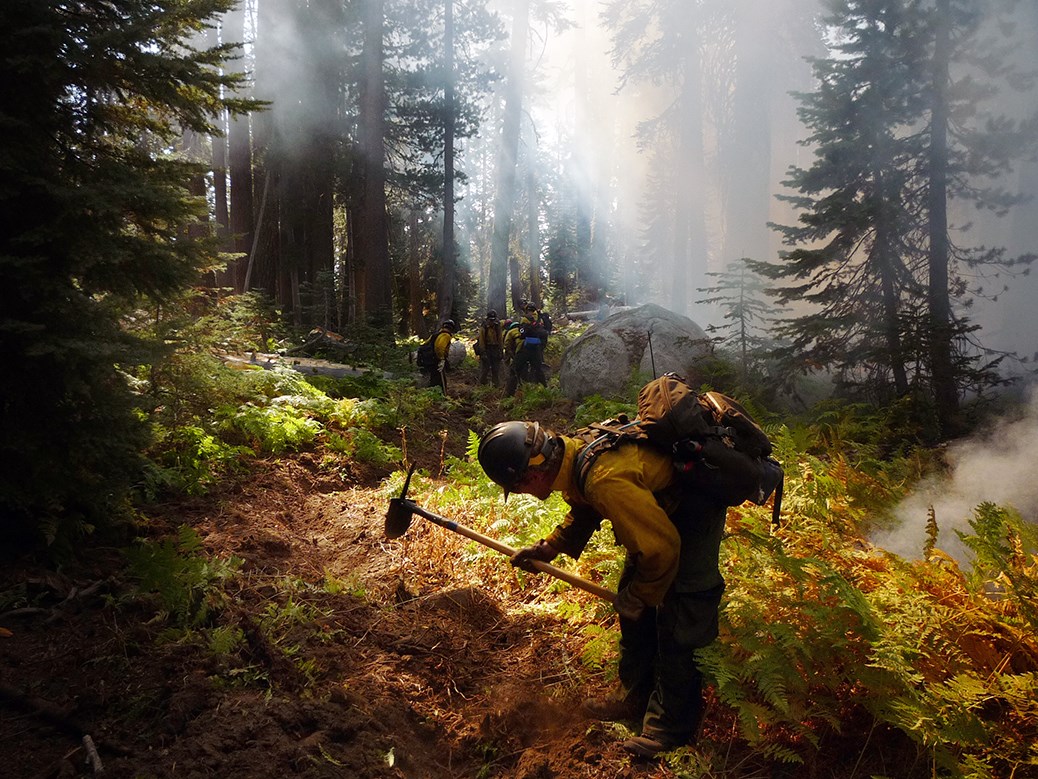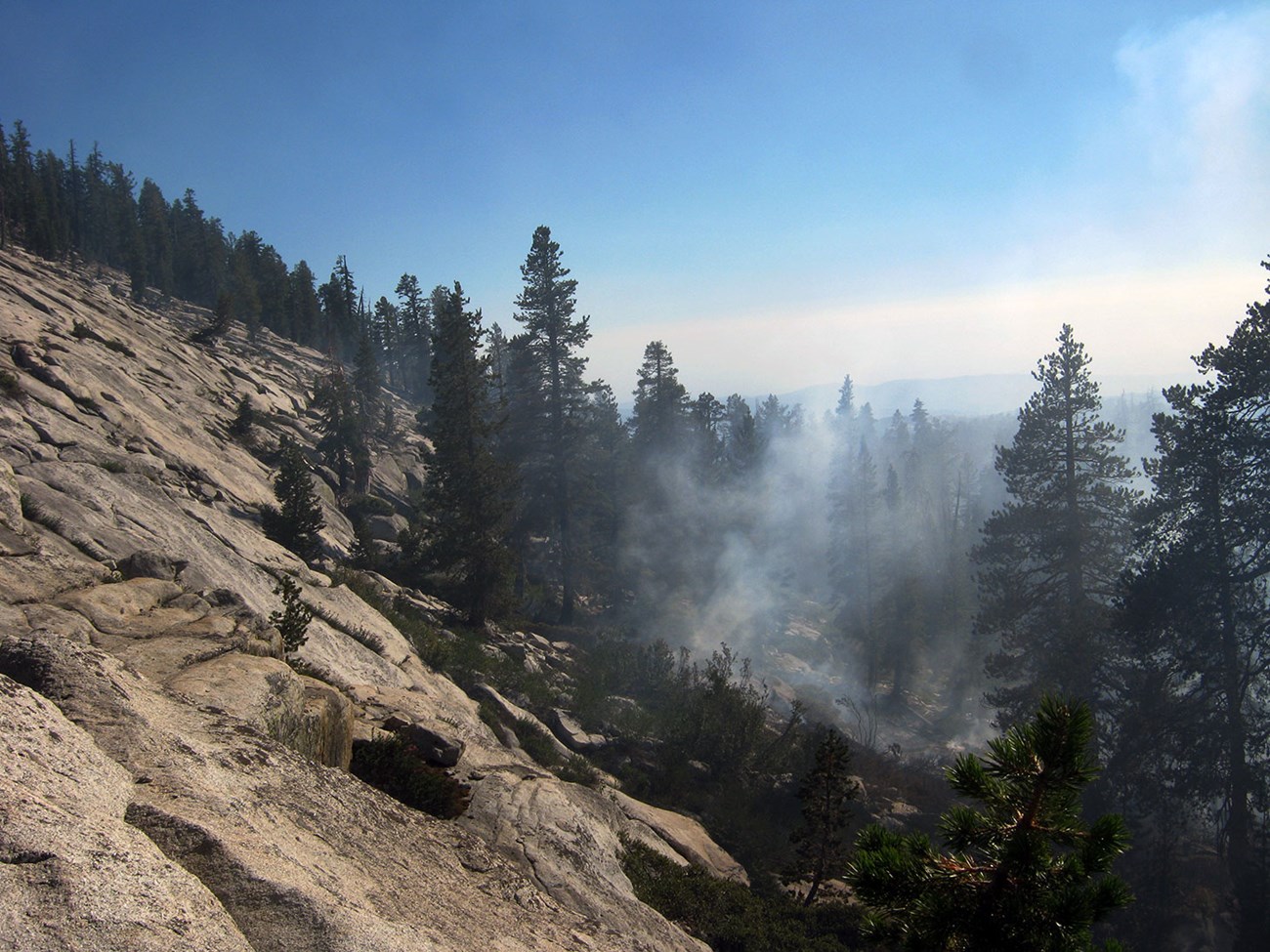Last updated: January 30, 2017
Article
Cascade Fire: Right Fire, Right Place, Right Time

June 15, 2012, began as a typical summer day in Yosemite National Park. The sun was brightly shining, but clouds and a lightning storm were predicted by late afternoon. The storm passed over with several lightning strikes hitting within the park. The park helicopter confirmed a strike, in a red fir snag, near Cascade Creek, in the northern portion of Yosemite, at approximately 8,000 feet elevation. Fire managers decided not to actively suppress this fire, called the Cascade fire. They did not know it then, but the Cascade fire would lightly burn for five months and become the right fire, in the right place, and at right time.
Cascade Creek is typically covered in snow on June 1, so the Cascade fire was burning in a “fire shadow,” or a place that receives plenty of lightning but few fires develop from ignitions. Cascade was the first fire in the area in nearly 90 years that was not suppressed. It occurred in a forest type that typically would have burned three times in that time period.
Park fire and resource managers determined that this fire was in such a remote location in designated wilderness, and with so few risks to people and resources, that putting firefighters in harm’s way was not worth the risk, as per federal interagency fire policy. Mindful attention was given throughout these discussions to issues including smoke impacts to surrounding communities and possible disruptions to visitor experiences. Smoke monitors were installed at six locations to measure air quality. Communication efforts with employees, visitors, gateway communities, park management, and air quality boards began on a daily basis.

Meanwhile, numerous fires had ignited in the western United States. Firefighting resources from Yosemite were dispatched to other states to assist in fighting these fires while the Cascade crept on. By midsummer, it was California’s turn to experience numerous lightning-ignited fires, and by August large wildfires were burning in several areas of the state. Yosemite fire personnel were dispatched to northern California for some particularly large fires.
As this was occurring, the Cascade fire continued to quietly creep. Educational opportunities now presented themselves as smoke was visible from several locations along Tioga Road, Highway 120. Fire staff posted fire information boards at locations of high interest, containing fire progression and perimeter maps, air quality charts, and the latest updates and information about the Cascade fire. Additionally, boards were installed in Yosemite Valley and all major entrance stations and communities where periodic smoke could be seen. Boards were updated weekly with the latest information. As the days rolled into weeks, then months, visitors seemed more interested in the fire facts and how it was being managed. Yosemite refined personal contact activities to be in locations where information officers could effectively talk with the highest number of visitors about the Cascade fire.
In late summer Yosemite experienced extreme fire conditions, resulting in firefighter duties being extended into evening and weekend hours. All new fires, whether natural or human-caused, were put out. Local community members were asked to be diligent in their personal property clearance and removal of potential fire materials. Fire prevention efforts were increased with messages directed toward visitors, campers, and backpackers concerning campfire safety.
All the while, the remote Cascade fire continued to smolder and creep through the forest as originally predicted in June. The only action that Yosemite firefighters took on the fire was to construct a half-mile check line. They tied together natural barriers to hold the fire from moving south toward the north rim of Yosemite Valley where the terrain was steep and dangerous for firefighters. Further, this line would help mitigate air quality impacts to the down-canyon communities of Foresta and El Portal.
In late fall, the Cascade fire’s unhurried behavior and growth began to taper. The first rain and snowflakes fell on the fire, and all but a few smoldering logs were extinguished. Fire information boards were removed as smoke no longer promoted the story to be told.
On November 19, the Cascade fire was officially declared out. In those five months, the fire had garnered much interest while behaving as predicted. It had burned 1,705 acres over five months, averaging 13-15 acres per day and never burning more than 30 acres per day. It cost approximately $200/acre to manage. Natural barriers of rock, streams, and forest type changes had driven the direction, and how the Cascade fire would be managed. Firefighter and public safety were the highest priorities, in addition to establishing honest, open communications and relationships with interested parties and park stakeholders, and restoring a forest ecosystem. Continuing communications over five months enabled the park to weave fire educational messages into conversations as a result of the Cascade fire.
As fire scientists and managers know, there are always appropriate locations to successfully manage fire, even in the driest of years. The Cascade fire was the right fire in the right place at the right time.
Contact: Kelly Martin, fire chief and fire management officer
Email: kelly_martin@nps.gov
Phone: (209) 372-0480
Contact: Taro Pusina, Yosemite deputy chief, fuels and prescribed fire
Email: taro_pusina@nps.gov
Phone: (209) 375-9576
Contact: Deron Mills, Yosemite deputy chief operations
Email: deron_mills@nps.gov
Phone: (209) 375-9572
